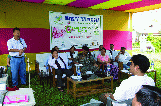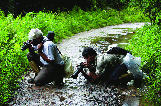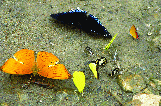Archives
The Winged Jewels of the ‘The Land of Bio-diversity’
The Butterfly India Meet was held for the first time in the North East at Jairampur in the district in 2006. It was organized by the Namchick Valley Society for Eco-Tourism and Wildlife Conservation and was a grand success. This time around, with a theme to promote nature tourism in the region as well as to bring back the lost glory of the Namdapha National Park and to bring these butterflies to the limelight besides serving as a common platform for butterfly researchers and enthusiast to discuss conservation issues, the national Level Butterfly India Meet 2010, the second of its kind in the region was jointly organized by Society for Environment Awareness and Conservation of Wildlife (SEACOW), Namchik Valley Society for Eco-Tourism and Wildlife Conservation (NSEWC) of Jairampur and the Butterfly India Group kicked off from July 19th and continued on till the 22nd in Arunachal Pradesh. The event did not have any sponsorship and was a meet of Butterfly India Core Group comprising of a bunch of enthusiasts from various pockets of the country. The 5 day long butterfly meet aimed at taking up a detailed survey of butterfly habitats, species, flora and fauna of Changlang valley.Red, Red Wings - Insect appeal Call it a beauty pageant with a difference. Butterflies and moths are some of the most fascinating and eye-catching flying insects. A vast majority are brightly coloured and are found all over the world, except in Antarctica. They are indeed one of the planet’s most beautiful creatures. People from all walks of life, irrespective of race, colour or religion enjoy these beautiful winged flying jewels for their delicate beauty. In India, most butterfly species are found associated with tropical rainforests. An amazing variety of butterflies thrive in the lush, dense tropical rain forests covering an area of 1985.23 sq. km, which forms the core of this natural paradise.
 The Land of Bio-diversity
The Land of Bio-diversity
Changlang district is home to hundreds of species of rare, endemic and exotic species of colourful butterflies, some of them extremely rare. Some species are so rare that they are found nowhere else in the country. An estimated 500 species of butterflies are found in Arunachal Pradesh. While in 2006 over 200 species were identified at Jairampur, more species were expected to be identified at Namdhapa this time at the meet. Butterflies come in a variety of sizes with two pairs of large wings. The color patterns vary from species to species and have a definite role to play in the protection of the species. If one were to closely observe the wings, it will be found that they are covered with overlapping rows of tiny scales.
Nature enthusiasts from different places including Chennai, Bangalore, Delhi, Maharashtra and Madhya Pradesh participated in the meet. The delegates coming from different professional backgrounds like naturalists, nature photographers, wildlife photographers, travel writers, IT consultants etc have been bonded together in their passion for these petite creatures fluttering across the virgin foliage of Arunachal Pradesh. The participants were divided into four to five groups and were taken to Namdhapa forest for photo documentation of the different species found in abundance at the tiger reserve. NSEWC Coordinator, Arif Siddiqui a conjurer in the realm of photography and the man behind the success of this Butterfly Meet informed that this Meet has offered the delegates a window to explore this magnificent land. It has also offered them an opportunity to meander across the Namdapha National Park in order to see and click some unknown species of butterflies, moths, spiders etc, he added. After the documentation, the findings will be handed over to the Forest Department. Moreover it was also a learning experience for the youth of this landlocked region.
participated in the meet. The delegates coming from different professional backgrounds like naturalists, nature photographers, wildlife photographers, travel writers, IT consultants etc have been bonded together in their passion for these petite creatures fluttering across the virgin foliage of Arunachal Pradesh. The participants were divided into four to five groups and were taken to Namdhapa forest for photo documentation of the different species found in abundance at the tiger reserve. NSEWC Coordinator, Arif Siddiqui a conjurer in the realm of photography and the man behind the success of this Butterfly Meet informed that this Meet has offered the delegates a window to explore this magnificent land. It has also offered them an opportunity to meander across the Namdapha National Park in order to see and click some unknown species of butterflies, moths, spiders etc, he added. After the documentation, the findings will be handed over to the Forest Department. Moreover it was also a learning experience for the youth of this landlocked region.
Breakfast with Butterflies
The meet also witnessed the participation of children from various schools in a conservation awareness program ‘Breakfast with Butterflies’ during which they were provided a wealth of knowledge on butterflies by many nature loving personalities who shared their experiences and expressed the need to conserve nature. The participants also studied the different species of moths under burning electric lamps in the evening at the premises of their cottages.
 Among them was the Butterfly India Group’s Moderator, Vijay Barve and J M Garh, author of Photo Guide to Common Birds of India who were at a loss for words in appreciation for this part of the country bestowed with nature’s beauty. They admitted that there were many rare species of butterflies in the area and urged the organisers to initiate many more similar events. “I was involved in organising the Butterfly India Meet in the Eastern Ghats in 2007 and participated in the Butterfly India Meet held in Goa in 2009,” informed enthusiast Minhajudding Ahmed Faruqi who also came from Hyderabad to participate in the Meet. Former Director of Zoological Survey of India, Dr. J.R.B Alfred said, “You are fortunate to be with nature. Please preserve it.” Naturalist & Wildlife Photographer Raghu Ananth expressed the need to initiate tree plantations and assured cooperation. Arjan Basuroy of Nature Mate expressed the need to take up plantation of indigenous plant species so that butterflies can be saved. As butterflies are cold blooded insects. In simple terms, they do not generate enough heat from their own metabolic activities to provide themselves with the heat and energy needed to fly. They rely on the heat absorbed from the sun. It is for this very reason that they often bask in the sun with wings outstretched. “Butterflies can only fly if their body temperature is above 86 degrees fahrenheit,” he added. General Secretary Phupla Singpho and the President Sethai Sena of the Society for Environment Awareness and Conservation of Wildlife (SEACOW) lauded the untiring contributions of all the experts, delegates and participants towards the success of the Butterfly Meet. Field Director of Namdapha National Park, S.S Jongsam said that Namdapha has many hidden treasures to be explored and invited cooperation from all to ensure that the beauty and significance of this tiger reserve is preserved. “The enthusiasm in their attitude indicates their excitement and expectations regarding this Meet and we hope we were able to satisfy their expectations,” said NSEWC Vice President James Jugli. Claiming Nampong, Jairampur & Miao as butterfly towns and as assets to the state of Arunachal Pradesh, nature lovers had nothing but words of praise for the organisers on the successful conduct of the Butterfly Meet 2010.
Among them was the Butterfly India Group’s Moderator, Vijay Barve and J M Garh, author of Photo Guide to Common Birds of India who were at a loss for words in appreciation for this part of the country bestowed with nature’s beauty. They admitted that there were many rare species of butterflies in the area and urged the organisers to initiate many more similar events. “I was involved in organising the Butterfly India Meet in the Eastern Ghats in 2007 and participated in the Butterfly India Meet held in Goa in 2009,” informed enthusiast Minhajudding Ahmed Faruqi who also came from Hyderabad to participate in the Meet. Former Director of Zoological Survey of India, Dr. J.R.B Alfred said, “You are fortunate to be with nature. Please preserve it.” Naturalist & Wildlife Photographer Raghu Ananth expressed the need to initiate tree plantations and assured cooperation. Arjan Basuroy of Nature Mate expressed the need to take up plantation of indigenous plant species so that butterflies can be saved. As butterflies are cold blooded insects. In simple terms, they do not generate enough heat from their own metabolic activities to provide themselves with the heat and energy needed to fly. They rely on the heat absorbed from the sun. It is for this very reason that they often bask in the sun with wings outstretched. “Butterflies can only fly if their body temperature is above 86 degrees fahrenheit,” he added. General Secretary Phupla Singpho and the President Sethai Sena of the Society for Environment Awareness and Conservation of Wildlife (SEACOW) lauded the untiring contributions of all the experts, delegates and participants towards the success of the Butterfly Meet. Field Director of Namdapha National Park, S.S Jongsam said that Namdapha has many hidden treasures to be explored and invited cooperation from all to ensure that the beauty and significance of this tiger reserve is preserved. “The enthusiasm in their attitude indicates their excitement and expectations regarding this Meet and we hope we were able to satisfy their expectations,” said NSEWC Vice President James Jugli. Claiming Nampong, Jairampur & Miao as butterfly towns and as assets to the state of Arunachal Pradesh, nature lovers had nothing but words of praise for the organisers on the successful conduct of the Butterfly Meet 2010.
Changlang District, one of the hotspots of biodiversity is unique and should be better protected and managed. There is mounting concern regarding the devastating losses to butterfly colonies because of unprecedented habitat destruction. This is the single greatest threat to butterflies. The rate of deforestation is accelerating and is already higher than the average as compared to other parts of the region. From egg to adulthood, butterflies undergo a metamorphosis that is complex and often beset with problems linked to weather, predators, lack of food and human encroachment on habitat. Commandant, Assam Rifles, Colonel Sandeep Chaudhury expressed pain at the way deforestation is being meted out. He reminded everyone that the people of Tirap and Changlang districts have a history of being attuned with nature and suggested that any activity which can be detrimental to nature should be avoided.
One of the most miraculous sights in nature is the life cycle of the butterfly — it goes through a complete metamorphosis as it passes through four distinct stages: egg, caterpillar, pupa and adult butterfly. So let us begin with the smallest steps by planting flowering plants in our backyards and thereby help native butterflies survive. In schools we need to encourage gardening and so also in public places with greenery all round as flowers rich in nectar will not only support rare butterflies, but other insects in the area too. Schools and colleges should conduct training programmes and guided field trips so that students learn firsthand the wild behavior of these beautiful winged jewels. School children from the primary level should be taught about butterflies and the vital role they play in different aspects of human life. Awareness at all levels will definitely help these winged jewels survive and coexist in a world dominated by humans.
Go ahead and observe the miracle of nature — it will humble you for sure; albeit delightfully.

